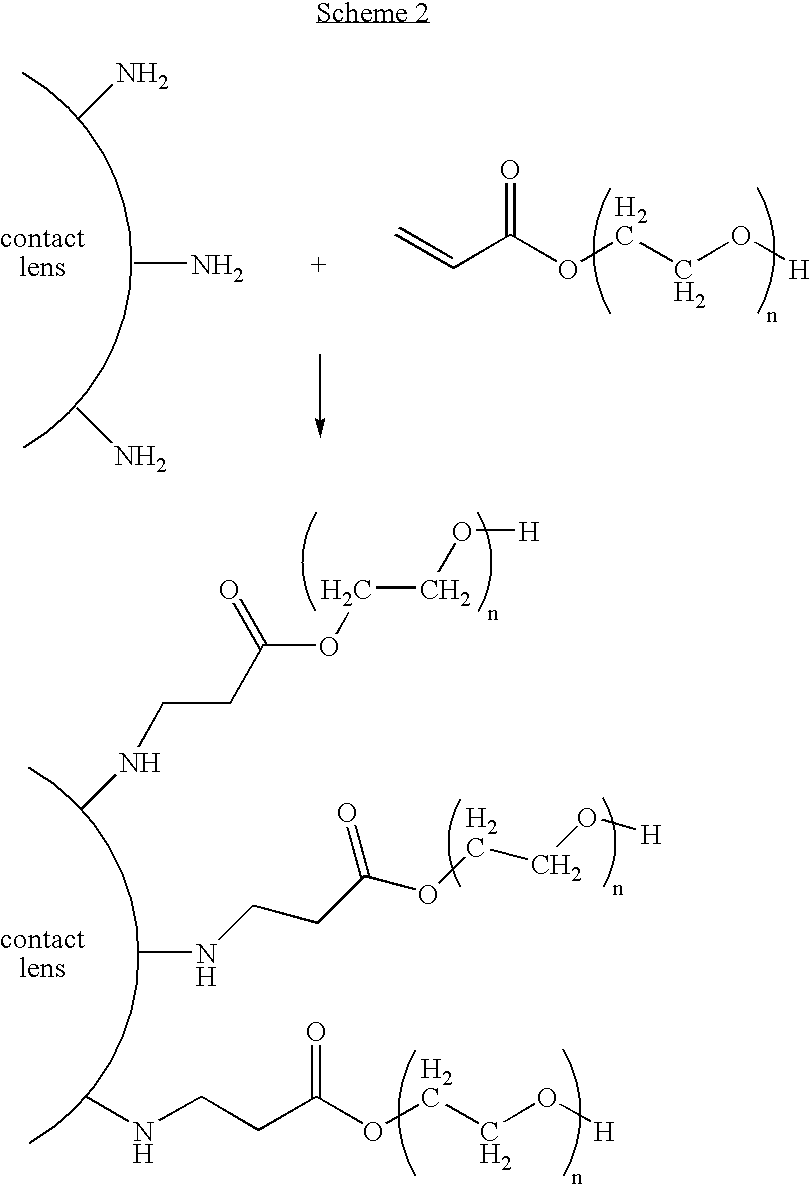Modification of surfaces of polymeric articles by Michael addition reaction
- Summary
- Abstract
- Description
- Claims
- Application Information
AI Technical Summary
Benefits of technology
Problems solved by technology
Method used
Image
Examples
example 1
Synthesis of Hydroxyl-Containing Poly(Vinylpyrrolidone)
[0095]To a 1000-ml three-neck flask equipped with a reflux condenser and nitrogen purge inlet tube were added 900 ml of 2-isopropoxyethanol (about 813.6 g, 7.812 mol), 30 ml of distilled NVP (about 31.3 g, 0.282 mol), 0.32 g (1.93 mmol) of AIBN. The contents were bubbled vigorously with nitrogen for 1 hour. While under moderate nitrogen bubbling and stirring, the contents were heated up to 80° C. for two days. The contents were then heated under vacuum to remove the 2-isopropoxyethanol solvent. Hydroxyl-functionalized poly(vinylpyrrolidone) (“PVP”) was obtained, having a number-average molecular weight of greater than about 1300, as determined by titration.
example 2
Preparation of Acrylate-Terminated PVP Polymer
[0096]To a thoroughly dried 500-ml round-bottom flask equipped with nitrogen purge inlet tube were added, under a flow of dry nitrogen, 16.95 g (12.49 mmol) of hydroxyl-functionalized PVP produced in Example 2 and 200 ml of anhydrous THF in succession. The flask was cooled with an ice bath. Under stirring, 2.72 g (26.88 mmol) of triethylamine was added to the mixture. Acryloyl chloride (2.333 g, 25.78 mmol) was added dropwise into the mixture. The reaction mixture was warmed up to room temperature and stirred under dry nitrogen for one day. Deionized water (25 ml) was added to the reaction mixture to give a clear solution. Acrylate-terminated PVP as 16.8% (by weight) solution in methanol was recovered using ultrafiltration to remove low molecular weight species. NMR analysis showed broad acrylate function presence in the polymer.
[0097]1H-NMR: 1H: 6.39 ppm, broad doublet; 6.18 ppm, broad multiple; 5.90 ppm, broad doublet; 4.83 single; 4.2...
example 3
Surface Treatment of Lenses via the Michael Addition Reaction
[0099]PureVision® contact lenses (comprising silicone hydrogel, Bausch & Lomb Incorporated, Rochester, N.Y.) were dried and then plasma treated sequentially with ammonia, butadiene, and ammonia to generate amine-containing groups on the surfaces of the lenses. The lenses were placed in glass vials. Freshly prepared methanol solution containing 16.8% (by weight) of acrylate PVP of Example 2 was then added to the glass vials, which were then set on a rotary machine for three days at room temperature. The treated lenses were rinsed with DI water and stored in borate buffer saline (“BBS”). Control lenses (only plasma treated) were extracted with isopropanol, rinsed with DI water, and placed in BBS. After being desalinated, both control lenses and coated lenses were subjected to standard surface analysis by XPS, and water contact angles were measured on the lenses. The results are shown in Table 1.
TABLE 1Comparison Between Trea...
PUM
| Property | Measurement | Unit |
|---|---|---|
| Water contact angle | aaaaa | aaaaa |
| Percent by atom | aaaaa | aaaaa |
| Percent by atom | aaaaa | aaaaa |
Abstract
Description
Claims
Application Information
 Login to View More
Login to View More - R&D
- Intellectual Property
- Life Sciences
- Materials
- Tech Scout
- Unparalleled Data Quality
- Higher Quality Content
- 60% Fewer Hallucinations
Browse by: Latest US Patents, China's latest patents, Technical Efficacy Thesaurus, Application Domain, Technology Topic, Popular Technical Reports.
© 2025 PatSnap. All rights reserved.Legal|Privacy policy|Modern Slavery Act Transparency Statement|Sitemap|About US| Contact US: help@patsnap.com



